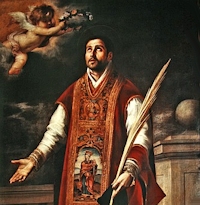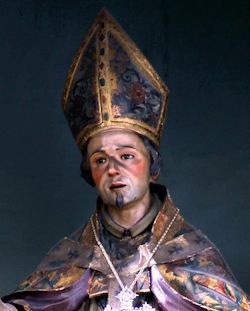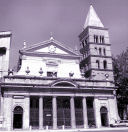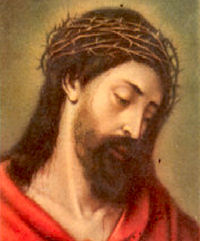Lent: March 13th
Monday of the Third Week of Lent
Other Commemorations: St. Roderick, Martyr (RM); St. Leander of Seville, Bishop (RM);
» Enjoy our Liturgical Seasons series of e-books!
The Liturgy today is concerned with Baptism. Water by itself cannot cleanse leprosy; but God can use it to do so. If God can cleanse the leprosy of the body with water there is no reason why he cannot use it to wash leprosy of soul. The second point which the Liturgy intends to bring home to us is that God’s salvation is offered and available to all men who believe in his words and obey them. —St. Andrew Bible Missal
The Roman Martyrology commemorates St. Roderick of Cordoba (d. 857), a priest and martyr who lived in Moorish Spain and beheaded in the 9th century. He was beheaded in 857.
St. Leander of Seville (534-600) is also commemorated today. He was bishop of Seville, preceding his brother St. Isidore of Seville. He fought against Arianism, presiding over the Council of Toledo and introduced the Nicene Creed to the Mass.
Meditation—Baptized in Christ
Baptism is a key word in Lent. As we know, its institution was as a period of intense preparation for baptism at the Easter Vigil, and ideally it still has this slant. Baptism is never over and done with. Baptism is a state—it must always continue. We have been put into a state of Baptism and we must live out the truth of that state.
What does it mean to be baptized? Various answers will come to mind, but if the answers are authentic they will reflect different aspects of the basic truth. Baptism is ultimately the sacrament of the Fatherhood of God, by it we become His sons and daughters, which is what humanhood is all about.
How is this metamorphosis of becoming a child of God effected? By dying to our purely natural life and being born again into new life, spiritual life, the life of the Risen Christ which is the life of God Himself.
How is this metamorphosis of becoming a child of God effected? By dying to our purely natural life and being born again into new life, spiritual life, the life of the Risen Christ which is the life of God Himself.
Baptism takes us up into the movement of Jesus, “I go to the Father.” We know the incredible pain, grief, darkness of that journey which we call the passion and death of Jesus. Basically it is our journey through the sadness and darkness sin or estrangement from God has caused. It is because our only way to the Father lies through death that Jesus died. He transformed that dark passage. Now it is truly a pathway of light leading straight to the Father.
We are summoned to faith. Summoned to deny, move off our own base and to stand on God’s fidelity as revealed in Jesus. We are summoned to accept His judgements, His values, His point of view; to surrender to His will, His guidance. The opposite of sin is not virtue but faith. Faith destroys sin as light destroys darkness.
To be baptized, to live in the state of baptism is to live in and by faith: not just to make acts of faith now and then but to live our lives by faith—absolute trust in the forgiving, self-donating God.
What we tend to do is live faith in fits and starts, acknowledging Him in some areas, denying Him in others. Baptism only becomes total when faith is total. Then truly we have died with Christ to a purely human life, and risen to His divine way of being.
There can be no realism in our living unless we keep our eyes on the blessed passion of Christ, and Lent is the time when the Church bids us accept the pain of having this sacred passion always before our eyes. In the passion we measure the greatness of His love, the seriousness of our lives with their countless choices, the certitudes upon which we base ourselves.
Lent is the time of effort, warfare, discipline. Let us look and look again at the suffering Jesus and take the weight of shame and sorrow.
It is often said, and rightly, that we cannot contemplate the death and resurrection of Jesus save in the radiance of the resurrection. But because of what we are, there is a need that, at a particular time of year we should, as it were, step out of this radiance and stand in the unredeemed dark—looking at what our sins have done, looking at what our redemption cost the Lord.
“You who have been baptized in Christ are clothed head to foot in Christ.” Let us accept the shame of the necessary stripping so that we may indeed rise anew at Easter, clothed in the glory of the risen Jesus.
—Ruth Burrows, Through Him, With Him, In Him
St. Roderick of Cordoba
 Jesus warned his disciples that they should expect no better treatment than Himself. They would be haled before governors and kings on His account, and brothers would even hand brothers over for execution.
Jesus warned his disciples that they should expect no better treatment than Himself. They would be haled before governors and kings on His account, and brothers would even hand brothers over for execution.
That prophecy was literally fulfilled in the case of St. Roderick, a Spanish martyr who died at the hands of the Muslim Moors in A.D. 857. His was a bitter case of the reverse of Christian love. We owe the account to eyewitness St. Elogius, who later on died for the faith himself.
It must be admitted that when the Mohammedans invaded Spain in A.D. 711, even they were sometimes shocked by the lack of religious principles among a large number of the Hispanic Christians. As the Moors swarmed in, the Catholics, far from presenting a strong front, became divided. Many, whether out of fear or lack of faith, voluntarily gave up their Christianity. Families thus split asunder and the members on either side railed at each other.
St. Roderick was to prove a sad victim of this sort of betrayal. He was a good priest of Cabra who had two irresponsible brothers. One of them was a bad Christian who had all but abandoned his faith. The other had gone still further and joined Islam. One night the two started to fight each other unmercifully. Roderick tried to break them up, but instead of yielding, they turned on him and beat him senseless. Then the Muslim brother had the priest put on a litter and carried half-conscious through the streets. The Muslim accompanied the bier, proclaiming that Father Roderick, too, had apostatized, and that he wanted it known publicly before he died. Eventually the victim did recover and went off to a safe place.
But Father Roderick had not yet seen the last of his renegade brother. The Muslim met the priest soon afterwards in the streets of Cordova. He had Roderick taken at once before the Mohammedan kadi (judge), where he accused him of the crime of having returned to Christianity after public profession of his Muslimism.
Although Father Roderick protested that he had never denied his Christian faith, the kadi clapped him into the city's worst dungeon.
In that fetid jail, the priest at least had the comfort of finding one Solomon, another Christian prisoner who had been accused of the same "unforgiveable" crime. Both of them were given a long term of imprisonment, in the hope that they would convert. But each man encouraged the other, and they remained firm in their Christian convictions. Even when separated, they would not change their belief.
Eventually, the kadi ordered the Catholic priest and the layman beheaded. St. Eulogius saw their headless bodies lying on the riverside. He noticed that the guards were careful to throw into the stream any stones stained with the men's blood, for fear the faithful might pick them up as relics.
The soldiers sought in vain to ward off veneration of SS. Roderick and Solomon. Spanish Christians would always honor them thereafter as martyrs. And they would also gradually learn from this heroism that the Faith is something really worth dying for.
—Father Robert F. McNamara, Excerpted from St. Kateri Tekakwitha Parish
Symbols and Representation: priest in Mass vestments holding a palm of martyrdom as an angel brings him a wreath of roses
Highlights and Things to Do:
- Read more about St. Roderick:
- Read this Essay, The Islamic Warriors' Destruction of a Nascent Civilization: the Catholic Kingdom of the Visigoths in Spain (A.D. 589–711) which appeared in the Winter-Spring 2011 issue of Modern Age to gain an understanding of the times in which St. Roderick lived.
St. Leander of Seville
 St. Leander was born of an illustrious family at Carthagena in Spain. He was the eldest of five brothers, several of whom are numbered among the Saints. He entered into a monastery very young, where he lived many years and attained to an eminent degree of virtue and sacred learning.
St. Leander was born of an illustrious family at Carthagena in Spain. He was the eldest of five brothers, several of whom are numbered among the Saints. He entered into a monastery very young, where he lived many years and attained to an eminent degree of virtue and sacred learning.
These qualities occasioned his being promoted to the see of Seville; but his change of condition made little or no alteration in his method of life, though it brought on him a great increase of care and solicitude.
Spain at that time was in possession of the Visigoths. These Goths, being infected with Arianism, established this heresy wherever they came; so that when St. Leander was made bishop it had reigned in Spain a hundred years. This was his great affliction; however, by his prayers to God, and by his most zealous and unwearied endeavors, he became the happy instrument of the conversion of that nation to the Catholic faith. Having converted, among others, Hermenegild, the king's eldest son and heir apparent, Leander was banished by King Leovigild. This pious prince was put to death by his unnatural father, the year following, for refusing to receive Communion from the hands of an Arian bishop. But, touched with remorse not long after, the king recalled our Saint; and falling sick and finding himself past hopes of recovery, he sent for St. Leander, and recommended to him his son Recared. This son, by listening to St. Leander, soon became a Catholic, and finally converted the whole nation of the Visigoths. He was no less successful with respect to the Suevi, a people of Spain, whom his father Leovigild had perverted.
St. Leander was no less zealous in the reformation of manners than in restoring the purity of faith; and he planted the seeds of that zeal and fervor which afterwards produced so many martyrs and Saints.
This holy doctor of Spain died about the year 596, on the 27th of February, as Mabillon proves from his epitaph.
The Church of Seville has been a metropolitan see ever since the third century. The cathedral is the most magnificent, both as to structure and ornament, of any in all Spain.
—Excerpted from Lives of the Saints, by Alban Butler, Benziger Bros. ed. [1894]
Patronage: Seville, Spain
Highlights and Things to Do:
- Read more about St. Leander:
- St. Leander was one of several saints in his family. He was the elder brother of Saint Isidore of Seville, Saint Fulgentius of Ecija, and Saint Florentina of Cartagena.
- The Cathedral of Murcia has a silver urn that contains the remains of the four sibling saints.

Wednesday of the Fourth Week of Lent
Station with San Paolo fuori le mura (St. Paul Outside the Walls):
After St. Paul's execution, his body was buried outside the walls of Rome on the road to Ostia. The first church built on this site was begun around 324. Because the original structure was so small and unable to accommodate the growing number of pilgrims, the church was rebuilt in 390. Despite much damage and restoration over the centuries, the current church looks similar as it was built in 390.
For more on San Paolo fuori le mura, see:
For further information on the Station Churches, see The Stational Church.








